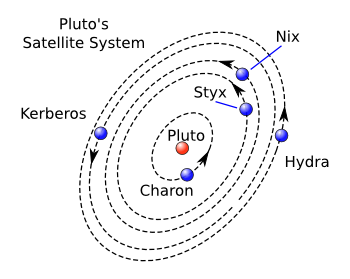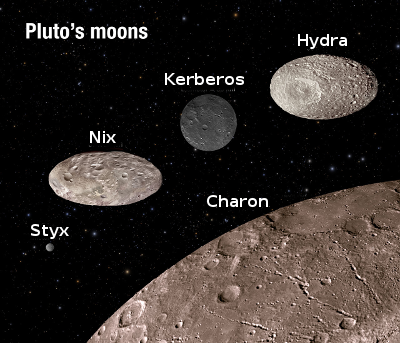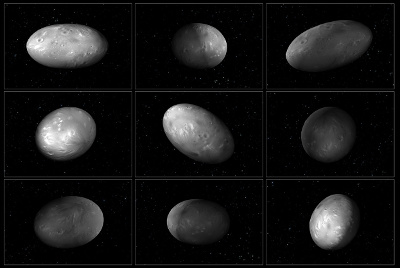The Chaotic Moons of Pluto
June 15, 2015
In the later part of the
20th century, advances in
instrumentation and our ability to send
spacecraft to other
planets in our
Solar System corrected many misconceptions in
planetary astronomy. One of these involved the
rotation rate of the planet,
Mercury. Mercury was always thought to be
tidally locked to the
Sun in having a
rotational period the same as its
orbital period of 88 days; that is, it would always present one face to the Sun.
Radar observations of Mercury in 1965 with the
Arecibo Observatory radio telescope showed a rotational period of 59 days, demonstrating an unusual 3:2
spin-orbit resonance in which Mercury rotates three times for every two orbits around the Sun.[1] It's easy to see why such a discovery didn't happen until 1965. The observation required a two
megawatt UHF transmitter beaming a 430
MHz signal through Arecibo's 300
meter dish antenna.[1]
The prime example of tidal locking is our
Moon. Only the
near side of the Moon is visible from
Earth. Our planetary neighbor,
Mars, has a tidal lock on both its
moons,
Phobos and
Deimos. In fact, the majority of moons in our Solar System are tidally locked, including
Saturn's largest moon,
Titan; and
Ganymede, the largest moon of
Jupiter and the largest moon in the Solar System. Nearly all others are suspected to be locked to their planets, while a few outer satellites of the
gas giants, distant from their host planet, are known not to be locked.

The moons in our Solar System are quite varied, as these photos of Phobos, Io, Europa, and Callisto show. (Phobos image by NASA/JPL-Caltech/University of Arizona; Io image by NASA/JPL/University of Arizona; Europa image by NASA/JPL/Deutsche Forschungsanstalt fuer Luftund; and Callisto image by NASA/JPL/Deutsche Forschungsanstalt fuer Luftund; all via Wikimedia Commons. Click for larger image.)
Although it's now denigrated to the status of "
dwarf planet,"
Pluto was hailed as a new planet when it was discovered in 1930. Pluto is so distant, located between thirty and fifty
astronomical units from the Sun in a highly
elliptical orbit, and so small (less than 20% the mass of our
Moon), that observations are difficult. From its discovery until 1978, Pluto was thought to be devoid of satellites. Then,
Charon, with about 11.6% Pluto's
mass, was discovered.
The close proximity of Charon to Pluto, coupled with Charon's considerable mass, make the Pluto-Charon couple an extreme example of a tidal lock. Pluto and Charon are mutually locked, so each presents the same face to the other. Their
barycenter, the center of their orbits around each other, is outside of Pluto.
The
Hubble Space Telescope has considerably expanded our knowledge of Pluto with the discovery of four additional moons.
Nix and
Hydra were discovered by Hubble in 2005, followed by
Kerberos in 2011 and
Styx in 2012. Aside from always reminding me of the
Care Bear plush teddy bears my
daughter had in the
1980s, Kerberos has the darkest surface of all Pluto's satellites.

The Pluto satellite system, showing the orbits of its five satellites, Charon, Nix, Hydra, Styx, and Kerberos.
(Illustration by the author using Inkscape. Click for larger image.)
The impending arrival next month of NASA's spacecraft,
New Horizons, has motivated recent observations of Pluto and its moons by the Hubble Space Telescope, and these have just been reported in the
journal,
Nature.[2-7] New Horizons visited Jupiter in February, 2007, when it got a
gravitational assist to propel it towards Pluto.
New Horizons will make the first
flyby of Pluto by any spacecraft on July 14, 2015. The Hubble observations of Pluto and its moons were by
Mark Showalter, a senior
research scientist at the
SETI Institute (Mountain View, California), and
Douglas Hamilton,
professor of
astronomy at the
University of Maryland (College Park, Maryland).[2-3]
As can be seen from the plan of the Pluto system, Charon orbits quite close to Pluto. This fact, combined with the more distant orbits of the other moons, has the effect that Nix, Hydra, Styx, and Kerberos are actually in orbit around both Charon and Pluto, which act as a
binary planet.[2] As a consequence, Pluto's moons are subject to unusual
gravitational forces.
Styx, Nix and Hydra interact in a
three-body resonance in which their orbits are
synchronized with each other, and Nix and Hydra rotate
chaotically, driven by the unusual gravitational influence of the Pluto-Charon binary planet.[2-3] These recent Hubble observations also confirmed the relative darkness of Kerberos compared with the other satellites.[3]

The shapes and relative sizes of Pluto's moons.
Kerberos is darker in color than the other moons.
(NASA/ESA image by A. Field (STScI), relabeled for clarity.)
Kerberos and Styx are also expected to exhibit chaotic dynamics.[4] Says co-author of the study, Douglas Hamilton,
"Like good children, our Moon and most others keep one face focused attentively on their parent planet... What we've learned is that Pluto's moons are more like ornery teenagers who refuse to follow the rules."[3]
Co-author Showalter observes that "Prior to the Hubble observations, nobody appreciated the intricate
dynamics of the Pluto system"[3] As can be deduced
intuitively, the orbital dance of the Pluto-Charon binary causes the remaining four moons to tumble unpredictably, and this effect is amplified by their
oblate shapes.[3] If it wasn't for their orbital resonance in which Styx orbits Pluto twice, and Hydra three times, for every orbit of Nix, these moons would crash into each other.[3-4]
Three of Jupiter's satellites, Io, Europa and
Ganymede, also have orbital resonance.[7]
Mathematical models indicate that all five of Pluto's moons were likely locked into a 1:3:4:5:6 resonance after an impact on a proto-Pluto formed Charon and the other moons. These ratios are very close to the orbital periods now seen for Pluto's moons.[7]

Artist's impression of a tumbling Nix.
(NASA/ESA image by M. Showalter (SETI Inst.), G. Bacon (STScI). Click for larger image)
The charcoal-like appearance of Kerberos is hard to reconcile with the proto-Pluto impact model for the system formation. If all the moons formed from the same
material, why does Kerberos look different? As Douglas Hamilton summarizes, "...If they all formed together, they all formed out of the same stuff. It is extremely hard to understand how one of them is a
charcoal briquette and it's orbiting between two
snowballs."[6]
Most scientists are thinking that New Horizons will discover more moons orbiting Pluto.
Alan Stern,
principal investigator for the New Horizons mission, is quoted in
Smithsonian Magazine as saying,
"If you polled my science team, I'm quite sure that the majority would be surprised not to find more moons... The question is are we going to find 2, or 10 or 20? I wouldn't put my bets on zero."[7]
Careful study of the Pluto system can lead to an understanding of
circumbinary planets, planets that orbit a
binary star. Seventeen such planets have been discovered to date.[3,6]
References:
- G. H. Pettengill and R. B. Dyce, "A Radar Determination of the Rotation of the Planet Mercury," Nature 206, vol. 206, no. 4990, (June 19, 1965), pp. 1240ff., doi:10.1038/2061240a0.
- M. R. Showalter and D. P. Hamilton, "Resonant interactions and chaotic rotation of Pluto's small moons," Nature, vol. 522, no. 7554 (June 4, 2015), pp. 45-49, doi:10.1038/nature14469. A PDF copy of the paper is available from the Hubble Space Telescope web site, here.
- Pluto's Moons Seen in Highest Detail Yet, University of Maryland Press Release, June 3, 2015.
- Hubble observes chaotic dance of Pluto's moons, Hubble Space Telescope Press Release No. heic1512, June 3, 2015.
- Hubble Finds Two Chaotically Tumbling Pluto Moons, Space Telescope Science Institute Press Release No. STScI-2015-24, June 3, 2015.
- Jonathan Amos, "Hubble studies Pluto's wobbly moons," BBC Web Site, June 4, 2015.
- Jay Bennett, "Weird Orbital Behaviors Offer Clues to the Origins of Pluto's Moons," Smithsonian Magazine, June 3, 2015.
Permanent Link to this article
Linked Keywords: 20th century; instrumentation; spacecraft; planet; Solar System; planetary science; planetary astronomy; rotation rate; Mercury; tidal locking; tidally locked; Sun; rotational period<; orbital period; radar; Arecibo Observatory; radio telescope; spin–orbit resonance; megawatt; ultra high frequency; UHF; transmitter; megahertz; MHz; signal; meter; parabolic antenna; dish antenna; Moon; near side of the Moon; Earth; Mars; natural satellite; moon; Phobos; Deimos; Saturn; Titan; Ganymede; Jupiter; gas giant; Io; Europa; Callisto; JPL; Deutsche Forschungsanstalt fuer Luftund; Wikimedia Commons; denigrate; dwarf planet; Pluto; astronomical unit; elliptic orbit; elliptical orbit; Moon; Charon; mass; barycenter; Hubble Space Telescope; Nix; Hydra; Kerberos; Styx; Care Bears; stuffed toy; plush; teddy bear; daughter; 1980s; satellite system; orbit; Inkscape; NASA; New Horizons; scientific journal; Nature; gravity assist; gravitational assist; space probe; flyby; Mark Showalter; research; scientist; SETI Institute (Mountain View, California); Douglas Hamilton; professor; astronomy; University of Maryland (College Park, Maryland); binary planet; gravitational force; orbital resonance; three-body resonance; synchronization; synchronized; chaos theory; chaotic; A. Field (STScI); child; children; parent; irritability; ornery; adolescence; teenager; discipline; rule; dynamics; intuition; intuitively; oblate; Ganymede; mathematical model; artist's impression; G. Bacon (STScI); charcoal; material; charcoal briquette; snowball; Alan Stern; principal investigator; Smithsonian Magazine; poll; majority; circumbinary planet; binary star.